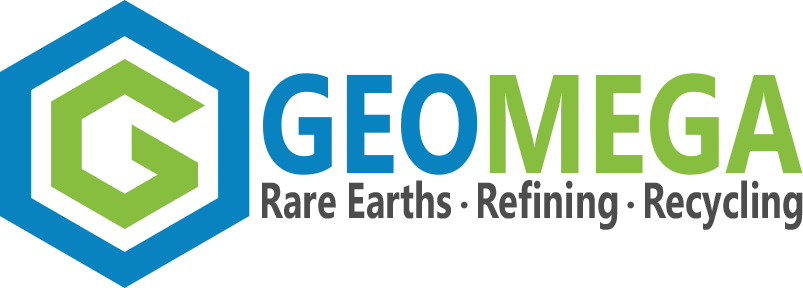Highlights of the news release are:
- Simultaneous separation of selected heavy REE (“HREE”) and light REE (“LREE”)
- Separation of HREE easier compared to LREE
- Separation of neighbour REE such as Dysprosium/Terbium and Neodymium/Praseodymium
- Conceptual separation process diagram (see graphic results)
Montreal, February 24, 2014 – Geomega Resources Inc. (“GéoMégA” or the “Company”) (TSX.V: GMA), is pleased to announce the successful conclusion of tests confirming physical separation of neighbour rare earth elements (“REE”) based on free flow electrophoresis technology. GéoMégA’s proprietary physical separation process has the potential to reduce the capital required to build separation facilities compared to conventional techniques (i.e. fractional precipitation, ion exchange and solvent extraction), optimize REE recovery and mitigate environmental impacts.
“Once the boundaries between the multiple disciplines of applied science fade out, a new technology emerges and it is where the effort of our innovation is devoted to.” comments Dr. Pouya Hajiani, Process Engineer of GéoMégA.
The objective of this series is to unveil the prominent potential of the technology to separate REE in a continuous process. Five (5) sets of tests using different separation protocols have been selected for the neighbour series. They consist of three (3) multi-element tests (A, B and C) associated with two complementary binary tests (B+ and C+).
- Synthetic mixture A contains Ytterbium (Yb), Dysprosium (Dy), Terbium (Tb) and Europium (Eu) representing the heavy to medium REE;
- Synthetic mixture B contains Europium (Eu), Neodymium (Nd), Praseodymium (Pr) and Lanthanum (La) representing the medium to light REE;
- Synthetic mixture B+ is the corresponding binary mixture to B, containing Pr and Nd. This result demonstrates the elemental isolation of neighbours (i.e. Nd and Pr) when they occur together in some channels during the first separation pass (see figure 2, channels 59 to 62);
- Synthetic mixture C contains Europium (Eu), Praseodymium (Pr), Cerium (Ce) and Lanthanum (La) representing the light REE;
- Synthetic mixture C+ is the corresponding binary mixture to C, containing Ce and Pr. This result demonstrates the elemental isolation of neighbours (i.e. Pr and Ce) when they occur together in some channels during the first separation pass (see figure 4, channels 64 to 69).
- All tests have been performed in a single pass using a laboratory scale prototype equipment;
- Total REE concentration is approximately 1 g/L (65 millimolar).
The graphic results (CLICK HERE) highlight the following features of the technology:
- Multicomponent separation of REE attained in a single pass;
- 100% purity separation of HREE is achievable in a single pass in the current process condition;
- 100% purity separation of medium to LREE is achievable in two passes in the current process condition;
- 100% purity separation of LREE is achievable in a continuous loop in the current process condition.
The next testing program of separation is to be performed on a commercial mixed REE concentrate. This round will aim to separate all REE and to address complexities of a real commercial mixture, including impurities. This program will also serve as a benchmark for future developments.
“Physics, when understood correctly, is predictable. The perfect binary separation of Nd and Pr with the currently limiting prototype equipment highlights a development team in control. We will ballpark a development timetable after the next testing program is completed.” comments Simon Britt, President and CEO of GéoMégA.
Added value of REE separation
The selling price of a mixed REE concentrate is evaluated according to the distribution of each REE and the impurities of the composition. As finished products require high purity individual REE, the value of the REE in a mixed concentrate is reduced by a significant percentage, i.e. between 25% and 100%. The reduction is based on the criticality (importance vs supply risk) of each REE. Currently, the most critical REE are neodymium (Nd) and dysprosium (Dy) due to increasing demand for powerful permanent magnets.
NRCC Boucherville research facilities
The neighbour series tests were performed by the Company’s development partner in Germany. The Company conducted all analyses at the National Research Council Canada laboratory in Boucherville, Canada. The analyses were done on every sample using ICP-OES spectrometer.
Dr. Pouya Hajiani, process engineer, supervised and approves the technical information of this news release.
About GéoMégA (www.geomega.ca)
GéoMégA, which owns 100% of the Montviel rare earth elements/niobium project located in Québec, is a mineral exploration and development company focused on the discovery and sustainable development of economic deposits of metals, such as rare earth elements, niobium and graphite, in Québec. GéoMégA is committed to meeting Canadian mining industry standards and distinguishing itself with its innovative engineering, stakeholders engagement and its dedication to local transformation benefits.
The common shares of GéoMégA shall resume trading on February 25, 2014.
GéoMégA currently has 42,825,238 common shares issued and outstanding.
Neither TSX Venture Exchange nor its Regulation Services Provider (as that term is defined in the policies of TSX Venture Exchange) accepts responsibility for the adequacy or accuracy of this release.
For further information please contact:
Simon Britt
President and CEO
GéoMégA
(450) 465-0099
Cautions Regarding Forward-Looking Statements
This news release contains forward-looking statements regarding our intentions and plans. The forward-looking statements that are contained in this news release are based on various assumptions and estimates by the Company and involve a number of risks and uncertainties. As a consequence, actual results may differ materially from results forecast or suggested in these forward-looking statements and readers should not place undue reliance on forward-looking statements. We caution you that such forward-looking statements involve known and unknown risks and uncertainties, as discussed in the Company’s filings with Canadian securities agencies. Various factors may prevent or delay our plans, including but not limited to, contractor availability and performance, weather, access, mineral prices, success and failure of the exploration and development carried out at various stages of the program, and general business, economic, competitive, political and social conditions. The Company expressly disclaims any obligation to update any forward- looking statements, except as required by applicable securities laws.
